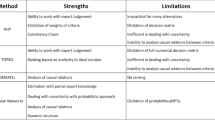Abstract
This paper presents an interactive procedure with incomplete information for supporting corporate strategic information systems planning (SISP), which is based on a prescriptive group decision-making method showing how to aggregate experts' incomplete preference judgments. The system, named CoSIS, is suggested on the competency leverage concept for selecting technical or organizational enablers to attain organizational business objectives. We put the competencies between the objectives and enablers, measure the importance rates of competencies on the objectives, and derive target enablers for the company. The importance of a competency is calculated using the SISP experts' incomplete preference information regarding relationships of importance rates between competencies on each objective. The Web-based architecture of CoSIS makes it relatively easy for the SISP team to obtain this preference information from distributed experts. Using the system, we carry out the experiments for performance evaluation of our procedure.






Similar content being viewed by others
References
Arthur Anderson Co . (1982). Method/1: An information systems methodology. Subject file AA4665, item 57.
Avison DE, Eardley WA and Powell P (1998). Suggestions for capturing corporate vision in strategic information systems. Omega 26(4): 443–459.
Basu V, Hartono E, Lederer AL and Sethi V (2002). The impact of organizational commitment, senior management involvement, and team involvement on strategic information systems planning. Inform Mngt 39(6): 513–524.
Earl MJ (1993). Experiences in strategic information systems planning. MIS Quart 17(1): 1–24.
Flynn DJ and Arce EA (1997). A CASE tool to support critical success factors analysis in IT planning and requirements determination. Inform Software Technol 39(5): 311–321.
Gallupe RB, DeSanctis G and Dickson GW (1988). Computer-based support for group problem-finding: An experimental investigation. MIS Quart 12(2): 277–296.
Gray P, Vogel D and Beauclair R (1990). Assessing GDSS empirical research. Eur J Op Res 46: 162–176.
Henderson JC and Venkatraman N (1999). Strategic alignment: Leveraging information technology for transforming organizations. IBM Syst J 38(2–3): 472–484.
Kathuria R and Igbaria M (1997). Aligning IT applications with manufacturing strategy: An integrated framework. Int J Op Mngt 17(6): 611–629.
Kathuria R, Anandarajan M and Igbaria M (1999). Selecting IT applications in manufacturing: A KBS approach. Omega 27(6): 605–616.
Kim JK and Choi SH (2001). An utility range based interactive group support system for multiattribute decision making. Comput Opns Res 28(5): 485–503.
King WR and Teo TSH (2000). Assessing the impact of proactive versus reactive modes of strategic information systems planning. Omega 28: 667–679.
Kotha S and Swamidass PM (2000). Strategy, advanced manufacturing technology, and performance: Empirical evidence from U.S. manufacturing firms. J Op Mngt 18(3): 257–277.
Lai VS, Trueblood RP and Wong BK (1999). Software selection: A case study of the application of the analytical hierarchical process to the selection of a multimedia authoring system. Inform Mngt 36: 221–232.
Lederer AL and Putnam A (1986). Connecting systems objectives to business strategy with BSP. Inform Strateg: Exec J 2(2): 12–18.
Lederer AL and Sethi V (1988). The implementation of SISP methodology. MIS Quart 12(3): 455–461.
Mentzas G (1997). Implementing an IS strategy—A team approach. Long Range Plann 30(1): 84–95.
Min SK, Suh EH and Kim SY (1999). An integrated approach toward strategic information systems planning. J Strateg Inform Syst 8: 373–394.
Newkirk HE, Lederer AL and Srinivasan C (2003). Strategic information systems planning: Too little or too much? J Strateg Inform Syst 12: 201–228.
Pant S, Sim HT and Hsu C (2001). A framework for developing web information systems plans: Illustration with Samsung heavy industries Co., Ltd. Inform Mngt 38: 385–408.
Pepparda J and Ward J (2004). Beyond strategic information systems: Towards an IS capability. J Strateg Inform Syst 13: 167–194.
Philip G and Booth ME (2001). A new six S framework on the relationship between the role of information systems (IS) and competencies in ‘IS’ management. J Bus Res 51: 233–247.
Porter ME (1985). Competitive Advantage: Creating and Sustaining Superior Performance. Free Press: New York.
Porter ME and Millar VE (1985). How information gives you competitive advantage. Harvard Bus Rev 63(4): 149–174.
Rockart JF (1979). Chief executives define their own data needs. Harvard Bus Rev 57(2): 81–93.
Saaty TL (1980). The Analytic Hierarchy Process. McGraw-Hill: New York.
Salmelaa H and Spil TAM (2002). Dynamic and emergent information systems strategy formulation and implementation. Int J Inform Mngt 22: 441–460.
Santhanam R and Kyparisis GJ (1995). A multiple criteria decision model for information system project selection. Comput Op Res 22(8): 807–818.
Santhanam R and Kyparisis GJ (1996). A decision model for interdependent information system project selection. Eur J Op Res 89: 380–399.
Schniederjans MJ and Wilson RL (1991). Using the analytic hierarchy process and goal programming for information system project selection. Inform Mngt 20: 333–342.
Somers TM and Nelson KG (2003). The impact of strategy and integration mechanisms on enterprise system value: Empirical evidence from manufacturing firms. Eur J Op Res 146: 315–338.
Teltumbde A (2003). A framework of evaluating ERP projects. Int J Prod Res 8: 4507–4520.
Teo TSH and Ang JSK (2001). An examination of major IS planning problems. Int J Inform Mngt 21: 457–470.
Venkatraman N (1994). IT-enabled business transformation: from automation to business scope redefinition. Sloan Mngt Rev 35(2): 73–87.
Wagner C (2004). Enterprise strategy management systems: Current and next generation. J Strateg Inform Syst 13: 105–128.
Wei CC, Chien CF and Wang MJJ (2005). An AHP-based approach to ERP system selection. Int J Prod Econ 96: 47–62.
Author information
Authors and Affiliations
Rights and permissions
About this article
Cite this article
Choi, S., Bae, S. Strategic information systems selection with incomplete preferences: a case of a Korean electronics company. J Oper Res Soc 60, 180–190 (2009). https://doi.org/10.1057/palgrave.jors.2602537
Received:
Accepted:
Published:
Issue Date:
DOI: https://doi.org/10.1057/palgrave.jors.2602537




